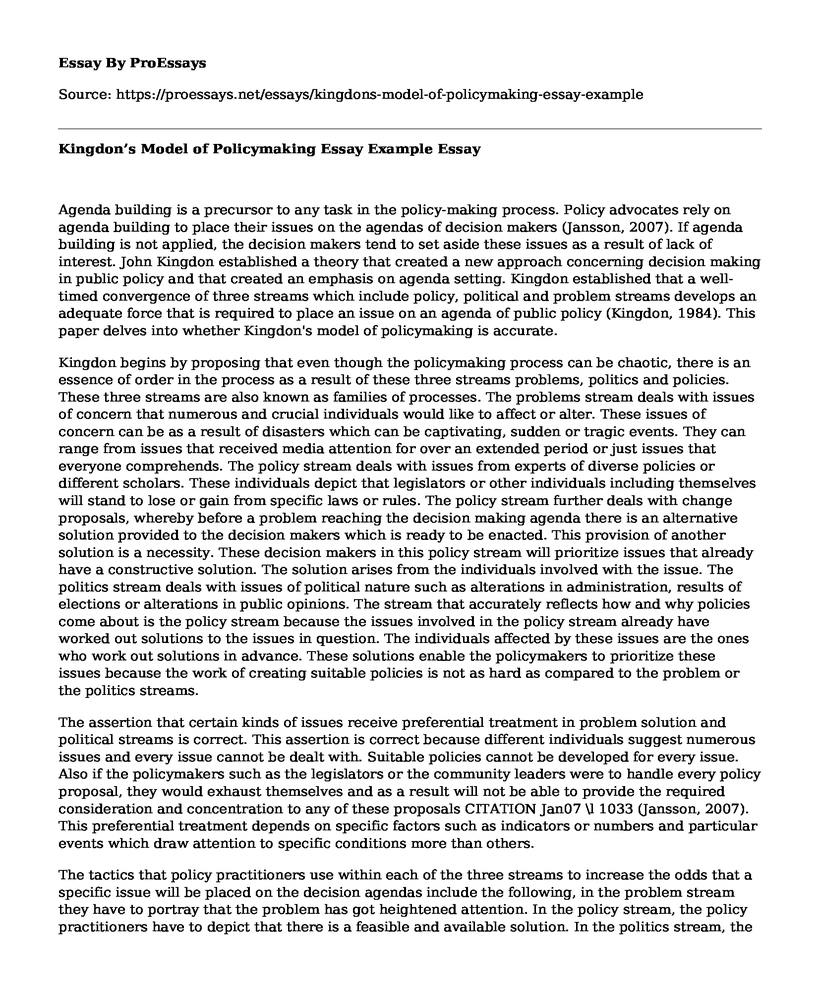Agenda building is a precursor to any task in the policy-making process. Policy advocates rely on agenda building to place their issues on the agendas of decision makers (Jansson, 2007). If agenda building is not applied, the decision makers tend to set aside these issues as a result of lack of interest. John Kingdon established a theory that created a new approach concerning decision making in public policy and that created an emphasis on agenda setting. Kingdon established that a well-timed convergence of three streams which include policy, political and problem streams develops an adequate force that is required to place an issue on an agenda of public policy (Kingdon, 1984). This paper delves into whether Kingdon's model of policymaking is accurate.
Kingdon begins by proposing that even though the policymaking process can be chaotic, there is an essence of order in the process as a result of these three streams problems, politics and policies. These three streams are also known as families of processes. The problems stream deals with issues of concern that numerous and crucial individuals would like to affect or alter. These issues of concern can be as a result of disasters which can be captivating, sudden or tragic events. They can range from issues that received media attention for over an extended period or just issues that everyone comprehends. The policy stream deals with issues from experts of diverse policies or different scholars. These individuals depict that legislators or other individuals including themselves will stand to lose or gain from specific laws or rules. The policy stream further deals with change proposals, whereby before a problem reaching the decision making agenda there is an alternative solution provided to the decision makers which is ready to be enacted. This provision of another solution is a necessity. These decision makers in this policy stream will prioritize issues that already have a constructive solution. The solution arises from the individuals involved with the issue. The politics stream deals with issues of political nature such as alterations in administration, results of elections or alterations in public opinions. The stream that accurately reflects how and why policies come about is the policy stream because the issues involved in the policy stream already have worked out solutions to the issues in question. The individuals affected by these issues are the ones who work out solutions in advance. These solutions enable the policymakers to prioritize these issues because the work of creating suitable policies is not as hard as compared to the problem or the politics streams.
The assertion that certain kinds of issues receive preferential treatment in problem solution and political streams is correct. This assertion is correct because different individuals suggest numerous issues and every issue cannot be dealt with. Suitable policies cannot be developed for every issue. Also if the policymakers such as the legislators or the community leaders were to handle every policy proposal, they would exhaust themselves and as a result will not be able to provide the required consideration and concentration to any of these proposals CITATION Jan07 \l 1033 (Jansson, 2007). This preferential treatment depends on specific factors such as indicators or numbers and particular events which draw attention to specific conditions more than others.
The tactics that policy practitioners use within each of the three streams to increase the odds that a specific issue will be placed on the decision agendas include the following, in the problem stream they have to portray that the problem has got heightened attention. In the policy stream, the policy practitioners have to depict that there is a feasible and available solution. In the politics stream, the practitioners have to depict that there is a political motive that supports the proposal (Kingdon J. W., 2001). These tactics have to all be applied at the same time.
References
Jansson, B. (2007). Becoming an effective policy advocate: From policy practice to social justice. Pacific Grove: Cengage Learning.
Kingdon, J. W. (1984). Agendas, alternatives, and public policies. Boston: Little, Brown.
Kingdon, J. W. (2001). A model of agenda-setting, with applications. L. REV. MSU-DCL, 331.
Cite this page
Kingdon's Model of Policymaking Essay Example. (2022, Jun 20). Retrieved from https://proessays.net/essays/kingdons-model-of-policymaking-essay-example
If you are the original author of this essay and no longer wish to have it published on the ProEssays website, please click below to request its removal:
- Essay on the Collapse of Kutai Kartanegara Bridge
- Reflection on a Discussion on U.S Constitution Day Paper Example
- After Watching Genocide Organ Essay Example
- Literary Analysis Essay on Jones' Book
- Political Views of Philosophers: Aristocracy to Democracy - Essay Sample
- Paper Example on Defining Success: A Comparison of Western and Eastern Perspectives
- Essay Sample on US Military Governance







